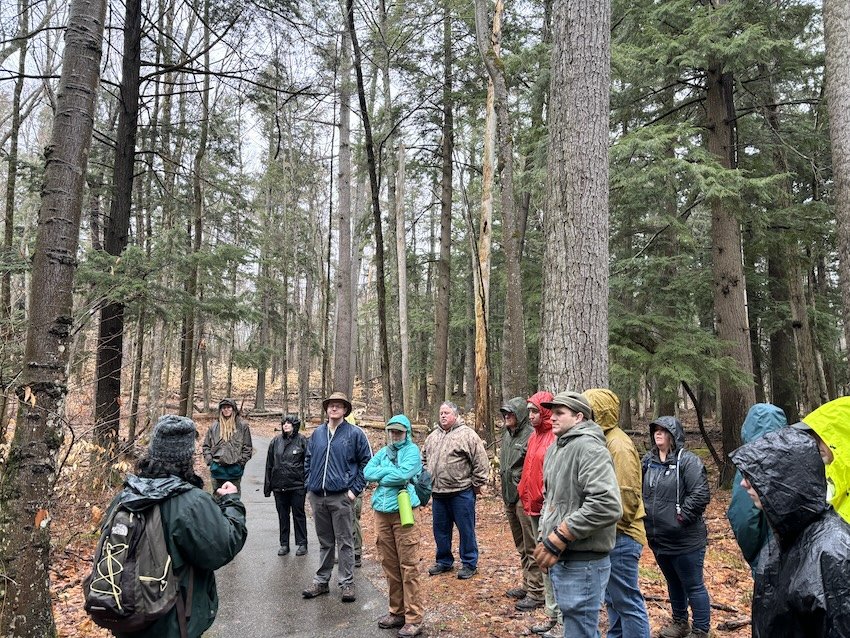The Lifecycle of a Raindrop
New Michigan Collaboration Brings Attention to the Importance of Forests for Water Quality
By Great Lakes Regional Manager, Leona Addie and Network Manager, Nick Sanchez
Have you ever stopped to think about the journey of a raindrop? From the moment it hits the ground to its eventual path through rivers and streams, every raindrop follows a remarkable route dictated by the landscape it encounters. This journey is guided by watersheds, nature's intricate and essential networks that shape how water flows across our planet.
A watershed is a natural basin that collects all the rain and snowmelt from its surrounding area. Imagine it as a giant bowl, where every raindrop or flake of snow that falls within its rim eventually finds its way into the same stream, river, lake, or ocean. Every piece of land on Earth is part of one watershed or another.
However, our watersheds face challenges, especially from pollution. Human activities such as industrial runoff, poor forest management and agricultural practices, poorly planned development, landscaping, and improper waste disposal can introduce harmful substances and excessive sediment into these delicate ecosystems. Pollution not only degrades water quality but also harms aquatic life and disrupts the balance of these natural habitats.
Forests play a crucial role in the delivery of clean water. They act as natural sponges, soaking up rainwater and releasing it slowly into streams and rivers. This process not only helps to regulate water flow, preventing floods and droughts, but also filters and purifies the water, making it more suitable for drinking. Michigan's extensive forests, spanning 20 million acres and encompassing 56% of its land area, are vital for protecting and purifying drinking water. Annually, these forests filter approximately six trillion gallons of rainwater, playing a crucial role in maintaining clean water supplies for households across the state.
Research from the U.S. Environmental Protection Agency (EPA) and the U.S. Department of Agriculture (USDA) Forest Service underscores the critical link between declining forest cover and deteriorating watershed conditions. For instance, Lake Erie's persistent issues with nutrient overloads and algae blooms are exacerbated by deforestation, the watershed now at only 19% forested. In contrast, Lake Superior, renowned as the cleanest of the Great Lakes, boasts a watershed that remains 91% forested. This extensive forest cover plays a pivotal role in preserving the lake's healthy water quality.
Not all forests are equal in their importance or ability to provide these ecosystem services. Forests growing along waterways play a more critical role, and the older the forest, the better. The old-growth forests, which once dominated the forests of the Great Lakes region, have the complex structure and functions that supply the large logs that provide fish habitat, create pools and diversify the river bed. This structure also reduces flood energy and prevents erosion. A single large crown can intercept thousands of gallons of rainwater. The deep, craggy bark of old trees channel rain to be absorbed by abundant mosses, lichens and liverworts and a deep root system beyond, contributing to water stored in the forest and slowly released rather than sent down a river in a flash flood. Complex, diverse canopies grown with time, provide the deep, layered-shade that keeps cold, oxygen-rich headwaters cool and the openings needed to support diverse aquatic plants. The combination of all of these features are abundant only in old-growth forests, making the protection and recruitment of old-growth paramount to the protection of clean water.
Recognizing the importance of forests and water to the wellbeing of Michiganders, the Michigan Department of Naturals Resources’ Forest Stewardship Program has launched Forest to Mi Faucet, a new initiative aimed at strategically planting trees, advocating for responsible forestry, engaging communities, building connections and collaboration between conservation organizations and the water utilities tasked with filtering and delivering water to users, and increasing awareness to forest landowners about the ecosystem services their forests provide and their options for better protecting and stewarding these resources. This initiative not only aims to maintain but also enhance the water quality benefits provided by forests across the state of Michigan.
The Old-Growth Forest Network is a proud partner of Forest to Mi Faucet. We are collaborating with 22 partners including watershed councils, land conservancies, conservation districts, and regional, state and national organizations. With support from the grant and our volunteers, OGFN will be planning community hikes, creating resources like the new Forest Management Plan Template for forest managers and landowners, and engaging people around the importance of protecting and caring for older forests for water quality and the many other ecosystem services they provide. Make sure you’ve signed up to receive our emails and look for invitations to upcoming events this fall.
Recommended places to visit in Michigan to observe the interactions of old forests and water:
Crooked Lake from Oden Island Nature Preserve - Emmet County
Lake Michigan & Flower Creek from Flower Creek Dunes Nature Preserve - Muskegon County
Sand Creek from Aman Park - Kent County
Dowagiac River from Newton Woods - Michigan State University Fred Russ Forest - Cass County





